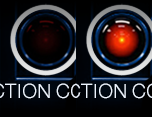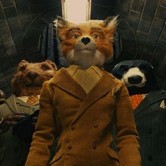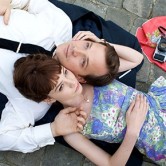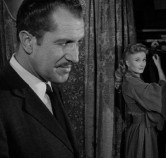Movie Review: CORALINE (2009)
![]()
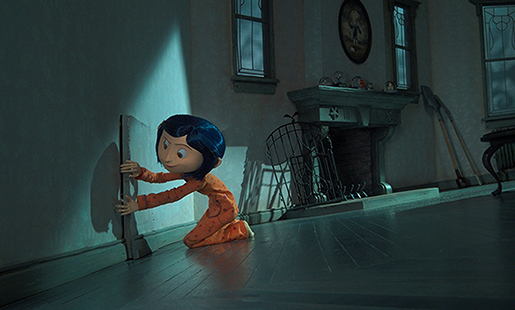
Grimm Girl
When I say “The Nightmare Before Christmas,” what is the first name that comes to mind? Tim Burton. Burton invokes visions of dark whimsy, and promises tours into a world that is distinctly his own. From the visual style and original story based on Burton’s illustrated book to his entire filmography coined a word that solely attributes to the artist and his world — Burtonesque. Hell, his name is in the title: Tim Burton’s The Nightmare Before Christmas. It takes a few more synapses in the brain to remember that Henry Selick was the film’s director. Selick made Jack Skellington come to life. Even the association of Burton as a producer blurs Selick’s accomplishment for his 1996 film James and the Giant Peach, based on the Roald Dahl novel. Finally, Burton is absent working on his adaptation of Alice in Wonderland due 2010. Selick is all alone here with the adaptation of Neil Gaiman’s Hugo Award winning novel.
Coraline is Selick’s baby.
11-year-old Coraline (Dakota Fanning) is an intelligent, waifish girl with dyed ink-blue hair. She has a bright, funky wardrobe including a loud, yellow raincoat and striped stockings. To her, the thought of attending a private school where she’d have to wear a grey uniform like everybody else is like opening her skull and smearing mud on her brains. Some may consider Coraline to be a little snot. She had my sympathies the second her face turned into a sour sneer. I could relate. I was easily peeved as a kid, and viewed authority skeptically. Most of my childhood felt like I was holding my breath, waiting for the smog to clear. I enjoyed my own pursuits, and had little interest in being “a good sport” about constantly being IT in games of Tag, among other childhood indignities. What gets Coraline through the day are her explorations outside on overcast afternoons, decorating with vibrant colours, and missing her friends after moving from Michigan into the deep woodlands.
Her precociousness clashes against the few eccentric denizens living in the rented levels of the Pink Palace Apartments. Mr. Bobinsky (Ian McShane), a blue-skinned, potbellied Russian vaudevillian trains mice for his small circus on the top floor. In the basement, one stout Miss Spink (Jennifer Saunders) and one very buxom Miss Forcible (Dawn French) are retired acrobats whose personalities might remind those Pushing Daisies fans of The Darling Mermaid Darlings. The designs of these two old crones were likely inspired by the characters Aunt Sponge and Aunt Spiker in Selick’s James and the Giant Peach (1996). The two provide Coraline with handy tea-leaf readings and decades-old sweets. The odd boy next door named Wyborn (Robert Bailey Jr.) – “Why were you born?” – is a motor-mouth whose steady steam of chatter rivals his own dirt bike. The poor kid’s awkwardness is amplified by his hunchback and skewed head. Unfortunately for him, Coraline isn’t a very empathetic person — a universal trait shared amongst most children. He just gets on her nerves.
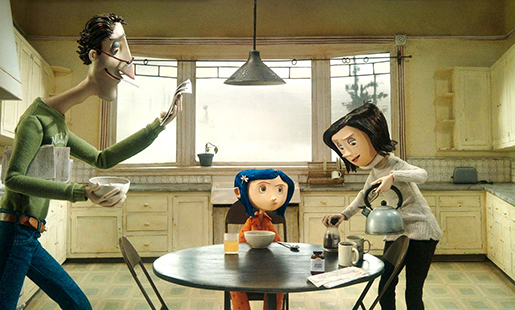
Coraline’s pale and harried parents are forever consumed by their laptops as they collaborate together on a gardening book…in separate rooms. The constant dismissal of their daughter’s pleas for attention provide little reprieve from her lumbering exploration of the grounds. Baggy-eyed Mother (Teri Hatcher) wears a neck brace and wears her daughter’s expectations out even more: “Dad cooks, I clean, and you stay out of the way!” Father (Mole-Man Expert John Hodgman), a gangly, laid back man contorts his head and long neck like a painful L while hunched over his monitor, hammering at the keyboard.
Frustrated by the dank malaise of her surroundings, Coraline happens upon a small door resembling the one in Lewis Carol’s Alice in Wonderland and the Charlie Kaufman penned Being John Malkovich (1999). Once inside, she is lured into a vibrant portal seen only by her. At the opposite end is a mirrored version of her world right behind her shoulder that appears to be much improved upon. Here the gloom is exchanged with eye-popping magic. The garden outside miraculously sprouts with beautifully alien vegetation and flowers. Her neighbors are younger and mind-blowingly talented. The food is scrumptious. The house is spotless. Coraline encounters her substitute parents who introduce themselves as her “Other” Mother and Father. They are infectiously upbeat, generous, and fun. You can tell by their sunny smiles and the black buttons sewn into their eyes.
Night after night, Coraline visits this bizarro world and is seduced by her Other Mother’s gifts and attention. “Everything’s right in this world.” One of the “fixes” in this world is that the Other Wybie cannot speak. This revelation should chill your spine. Coraline is immediately pleased, but later asks the Other Wybie if it hurt. A smaller observation not commented on is just as troublesome: the Other Wybie doesn’t eat his cotton candy. Following the implacable nightmare logic of a genuine Grimm fairytale, Coraline gradually realizes with mounting horror what sinister truths lie behind the happy curtain. “They say even the proudest spirit can be broken…with love.”
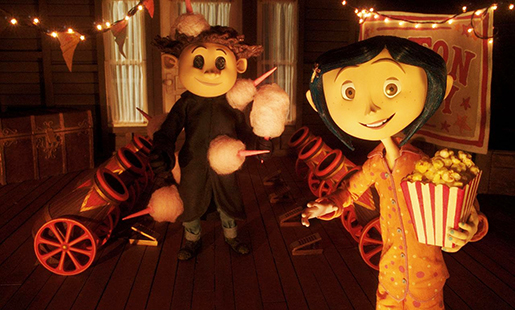
The tension heightens through the cheerful deposition of the villains, which is more difficult to accomplish than discovering menace in very dark places. The brighter the picture, the darker the negative. This is reminiscent of the ominous tone in Peter Weir’s The Truman Show and The Twilight Zone episode Number Twelve Looks Just Like You by Rod Serling. Good, sparse dialogue like “We don’t remember our names” hammers the nail in the heart swiftly.
Coraline, well-played by Fanning, is a fascinating heroine to root for because she feels so relatable and human. Had I watched this film as a kid, I would have had a crush on Coraline. It is a joy to behold her personality and tastes because she confirms how frustrating it feels to be a kid. She is divorced from the thousand carbon copies of kid characters foisted onto us by conservative adults as merely “good examples”. There comes a point when smart, empathetic kids have learned all the obvious lessons from the How to Lead a Good Life Manual such as looking both ways before crossing the street and understanding the damning consequences of emotional and physical hurt. After they have graduated this (otherwise known as Kindergarten) and left behind the narrow-minded, the bigoted, the crippling literate, the half-wits, and the sociopaths who ruin everything for the rest of us, their minds thirst for the wit of Mark Twain, the irony of Roald Dahl, and the dark fanaticism of Neil Gaiman.
Teri Hatcher does her best work playing Coraline’s Mother and her Other Mother. Her performance is so subtle in the way she doesn’t change her voice intrinsically, but changes the inflection to create two very different and specific personalities. We believe there are two different characters. Like Madam Mim, the Other Mother loves games. Notice how Coraline’s mother is consistently true to herself throughout, just because she is low-key doesn’t mean she doesn’t love her daughter any less. Less sophisticated filmmakers would have been insultingly obvious and made Mom smother Coraline with kisses and tearfully beg her forgiveness for not understanding her. Thank goodness she doesn’t.
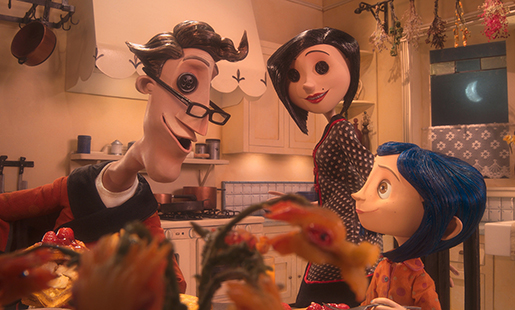
The designs of the character models are sharper and more diagonal than the occasionally rounded renderings. Shane Prigmore, Shannon Tindle, Damon Bard are among the number of character designers whose invaluable contributions to Coraline are showcased by the dependably drawn.ca in their blogs The Art of Coraline. Also worth examination are the blogs The Coraline Production Art by Chris Turnham and The Marketing of Coraline.
The costume design of the Other Mother is ingeniously creepy, the outline behind her dress resembles the backside of a wasp’s tail. As her demeanor worsens, her physique transforms into that of an arachnid. Also, the attire of the “other” aged acrobatic sisters is very cheeky. The outlining of the characters faces, even the pointy shape of Coraline and her Mother’s nose are somehow endearing. The facial expressions are a joy to behold. The utterly eerie main title sequence — in the same tradition of David Fincher’s groundbreaking sequence in Se7en with the making of John Doe’s many exhausted notebooks — showing us the reformation of the Caroline doll aptly named “Little Me” owes a hand to the Brothers Quay. One shot makes the doll’s stuffing look like moldy guts. When Coraline hits DVD, the freeze frame button is going to be exhausted.
The Hallucinatory Hospital Scene in Julie Taymor’s Frida by the Brothers Quay | Music by Elliot Goldenthal
The Main Title Sequence of David Fincher’s Se7en.
The fluid stop-motion animation has a delightfully herky-jerky quality when characters and objects move slowly. Look at the way Coraline squints as she looks into the blue and violet velvety portal for the first time. You can practically count the frames of film as her eyelids move. Watch how a hundred keys appear to scuttle when they are jerked forward by the opening of the drawer they are in. Even the bouncing circus mice look as though they are duplicating when they jump in the center ring. These moments feel more deliberate by the craft of human hands, rather than having the sleek and shine of a CGI effect suck the soul out of them.
My problem with the animation of Corpse Bride (2005), directed by Tim Burton and Mike Johnson, is that the slick perfection of its stop-motion made it look as though it was rendered on a computer. The little nicks of Coraline’s animation feel truly tactile. It twitches with the deliberate movements of a housefly. Selick and his animators are having a blast exploiting the tricks of the human eye, and the result is far more impressive. I look at Coraline and believe the sets and dolls were built, then meticulously photographed. The end credit sequence resembles the singular character interactions of the floating bunnies in Nick Park’s Wallace and Gromit: The Curse of the Were-Rabbit, also released in 2005.
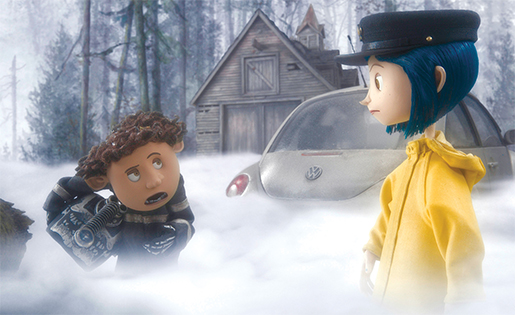
The sophisticated tracking of the camera along the beautifully designed small-scaled sets makes the feature feel more cinematic — particularly an early shot of the camera tilting from behind and then above a rock overlooking Caroline playing “water-winch” in the woods. It’s amazing how the production design of the expansive forest and stark hills looks as though there is actually more beyond the horizon. Occasionally, skeletal hand-shaped clouds crawl across the moon. The swirling background of a child’s desolate hell, inside a warped closet and no doors, is inspired by Vincent Van Gogh’s The Starry Night. Another nice touch is the “Shakespeare Festival” banner hanging in the town square.
The creepy music by French composer Bruno Coulais is worthy of note here. My favourite of Coulais’ past work is for Microcosmos: Le Peuple de L’herbe (1996), a documentary about insects (Lyrics: “Open Your Eyes Before You Die.”). Highlighting the harp and strings score is The Children’s Choir of Nice, whose voices manage to chill and tickle the bones. A ghostly voice belonging to the composer singing “dreaming…” on the soundtrack is particularly unnerving. Coulais playfully suggests that something wicked this way comes…closer. Listen for the subtle organ when the “other” parents put Coraline to bed. Certain instruments are reserved for specific characters, for instance Mr. Bobinsky is heavy with horns. The tracks “It Was Fantastic” and “Ghost Children” on the soundtrack best convey the film’s enveloping gloomy despair.
“Microcosmos” (1996) | Music by Bruno Coulais
Coraline is a rite of passage for kids coming of age to appreciate more extreme fare. All of the best films for children and adults alike are the ones willing to unsettle and even scare the kiddie-winks. Pinocchio (1940) is infamous for the frightening scene where the boys are transformed into donkeys, not to mention that hideous grin of The Coachman. The Great Mouse Detective (1986) has Ratagan’s lackey Fidget, a cackling bat with fangs, jump out of the shadows. In Hayao Miyazaki’s Spirited Away (2002), I was really disturbed by the sight of Chihiro’s parents having transformed into heavy, unintelligible hogs with chewed food dripping down their chins. That’s one of the reasons why I adore that film so much. The Disney masterpiece Beauty and the Beast (1991) has the menacing Beast hidden in darkness, silently stalking Maurice who had entered the haunted castle in a desperate bid for shelter from the storm.
The colour restoration of the Beauty and the Beast DVD was unwisely brightened so the Beast’s features can be made out in the dark shadow. In order to correct the picture of Beauty and the Beast, I advise you to turn down the brightness of your television screen to make the Beast’s piercing blue eyes the only things you can see against the blackened figure. When Belle requests that the Beast come into the light, he should emerge from black shadows for a greater dramatic effect.
Is Coraline too intense for kids? Yes — just wait until you see what’s left of the “Other” Wybie! — but that shouldn’t stop them from seeing it. As a kid, the alarming experiences at the movies were more compelling than the fare deemed safer. Darker children’s films that initially frightened me would still command my attention and I would keep them just as close to my heart as I grew up. It is better to be scared than bored. Upon my second viewing of Coraline, I saw the matinée showing with a young mother and her four-year-old daughter. I occasionally observed the little girl’s reaction during the scary moments and guess what, she was leaning over the edge of her seat, fascinated. The only time she jumped was when the witch was hungrily reaching for Coraline. I think she’s going to treasure this film as she grows up.
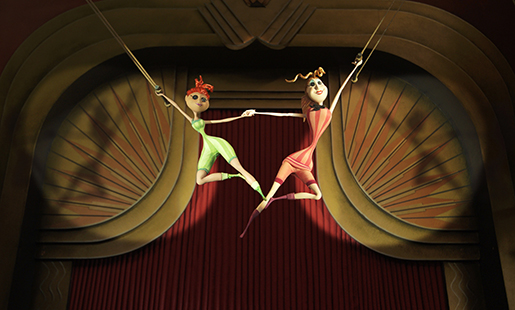
Make no mistake, Coraline may well be the first mainstream animated horror film – but it’s a real horror film of substance! It’s a shame that it has taken this long. Hopefully the first R-rated animated horror film is at the outset. I share Brad Bird’s complaint that animation is considered by many as a genre unto itself and walled off from transcending other genres like Drama and Horror. Animation doesn’t just belong to the kids. Only the naïve and the inattentive think otherwise. Animation is a medium that can explore as far (maybe farther than) live-action can. It is a train, not a destination.
Coraline is closer in spirit and tone with the Oscar-nominated, five-minute 1991 classic The Sandman, directed by Paul Berry. While peering tensely at an innocent little boy trying to sleep, a cruel creature commits an act as God made nature “bloody in tooth and nail”. Keep in mind that the kids have to be fed at the end of the day. It is very disturbing and, consequently, one of my favorites.
Paul Berry’s “The Sandman” (1991)
For the past couple of years, the month of February has adapted a trend of releasing one great surprise amongst a mediocre batch of movies. These surprises achieve staying power, the films themselves range from near-to-complete masterpieces that were high up on my list of the best that given year. 2007, it was David Fincher’s Zodiac, an ingenious police investigation of the allusive San Francisco serial killer. In 2008, it was Martin McDonagh’s In Bruges, a darkly comic drama about people who kill for a living. Though it isn’t as perfect as those last two; this year, it is Coraline.
CORALINE (2009) Trailer
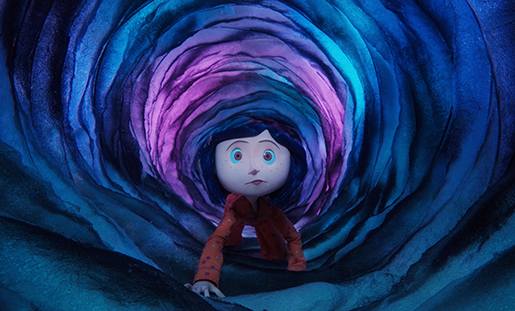
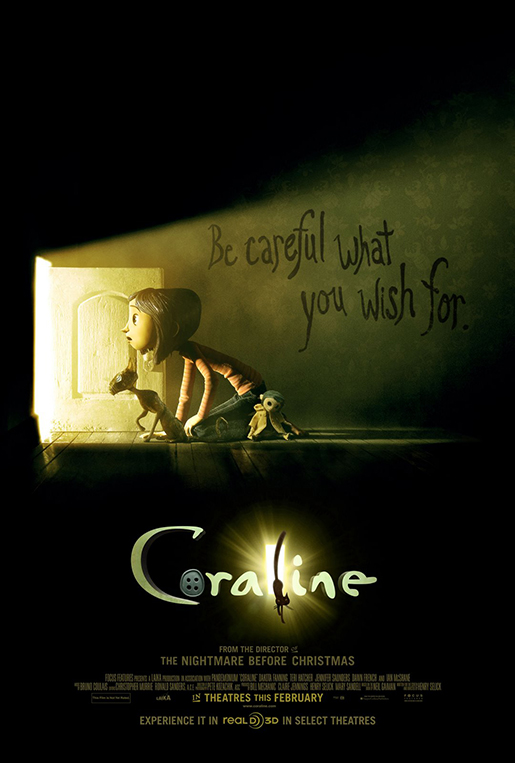
© 2008 – 2024, CINELATION | Movie Reviews by Chris Beaubien. All rights reserved.


